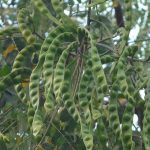 The fruit pod of the Leguminosae/Fabaceae, derived from a single carpel, usually (though with many exceptions) opening along a suture into two halves, usually dry;
The fruit pod of the Leguminosae/Fabaceae, derived from a single carpel, usually (though with many exceptions) opening along a suture into two halves, usually dry;
Colloquial term used by botanists for any member of the Leguminosae/Fabaceae.
Considering that life is essentially a “gathering in” of things we need for survival, it’s not surprising that nearly thirty English words have derived from legere, a Latin verb originally meaning to gather. Some of the descendants of legere include legend, lecture, intelligent, neglect, and legume. With legume it is fairly easy to see the semantic connection: legumes are plants such as beans or peas whose pods may be picked or “gathered” by hand; this, at least, is how the ancient Romans defined such plants, and accordingly they used legere to form the vegetable name legumen. This Latin word was then adopted by French as legume, which was subsequently adopted by English in the late seventeenth century. The idea of gathering is also fairly close to the surface of the word intelligent, intelligence being the ability to “gather in” data from the outside world. One way of gathering such data is by reading, and in fact to read eventually displaced to gather as the primary meaning of the Latin legere. Thus, the word legend literally means something to be read, the word lecture literally means about to read, and the word neglect literally means something unread or, more broadly, something not gathered in.
Characteristic of the Leguminosae family; usually a dehiscent fruit formed by one carpel with two dehiscent sutures; any plant with this type of fruit.
Members of the family Leguminosae, consumed as dry mature seeds (grain legumes or pulses) or as immature green seeds in the pod. Legumes include the groundnut, Arachis hypogaea, and soya bean, Glycine max, grown for their oil and protein, the yam bean Pachyvrhizus erosus, and African yam bean Sphenostylis stenocarpa, grown for their edible tubers as well as seeds.
Beans, peas, lentils and peanuts as examples.
A simple pod that splits into two pieces—like that of the pea.
A fruit consisting of one carpel, opening on one side, such as a pea.
A seed pod (as in the pea family) that splits along two sides; a member of the pea family.
A member of the large pea family, which includes peas, beans, clover, lupins, wisteria, acacias, the various brooms, and some trees such as the cassias. They all share the ability to draw nitrogen straight from the air, by courtesy of bacteria that live in nodules on their roots.
A fruit consisting of a single carpel, breaking open along 2 sides—a string bean, for example. Also used to refer to a member of the Leguminosae family.
A member of the large pea family (Fabaceae or Leguminosae), which includes peas, beans, clover, lupins, wisteria, acacias, the various brooms, and some trees such as the cassias and locusts. They all share the ability to draw nitrogen straight from the air, by courtesy of bacteria that live in nodules on their roots.
The edible seeds of leguminous plants which are usually good sources of protein. These include the pulses, and certain oilseeds like the groundnut and soyabean.
Plants having seed-containing pods that are used as food.
A family of plants with seeds (peas or beans) in a pod.
A large family of plants that have nodules on their roots containing nitrogen-fixing bacteria. Peas and beans are legumes. Some legumes contain substances that interfere with vitamins or have other antinutrient effects.
A legume is a plant that has nodules on its roots containing nitrogen-fixing bacteria. Peas and beans that are typically dried prior to preparation are examples of legumes in the diet.
